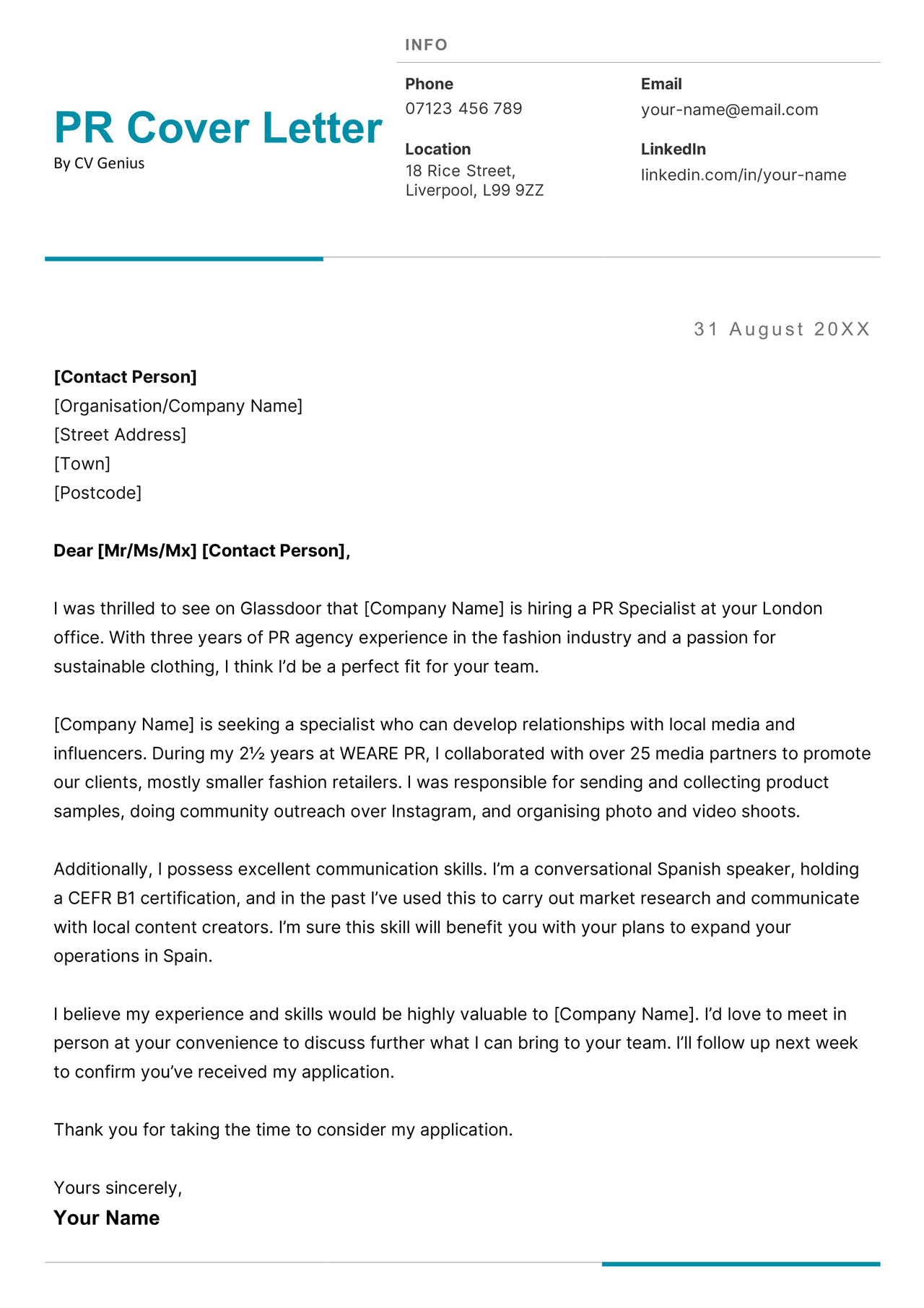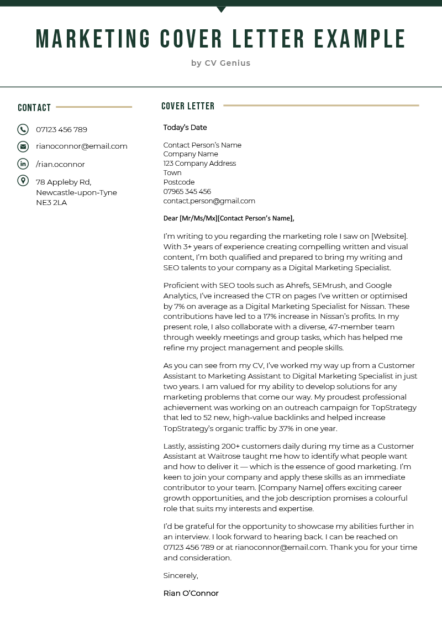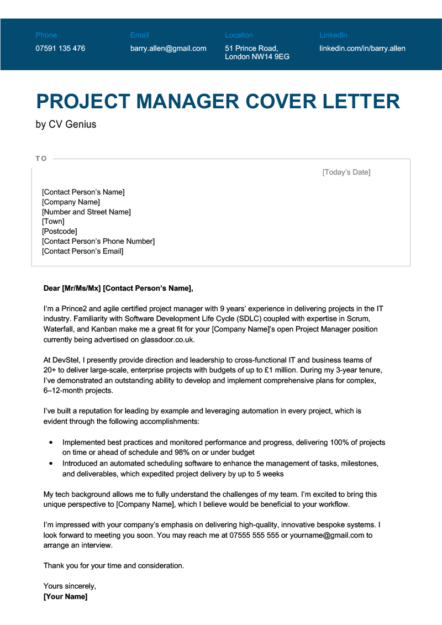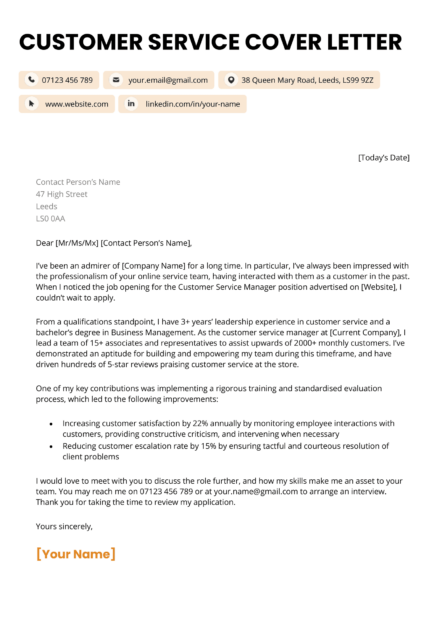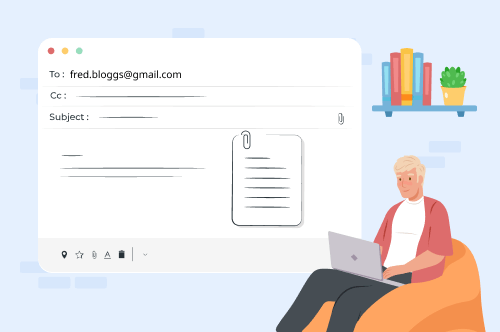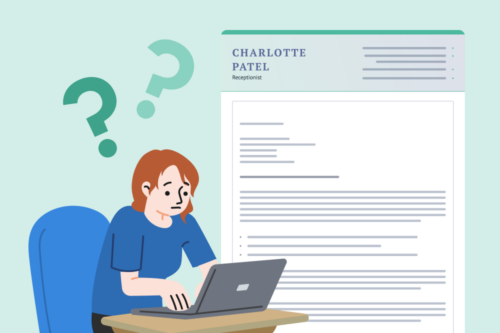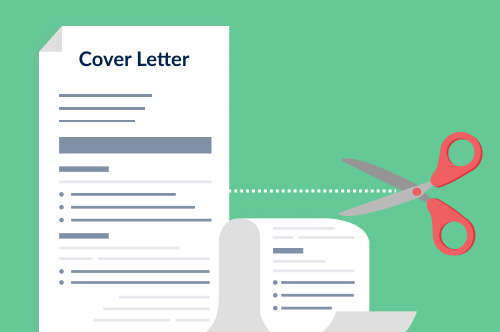Be sure you use the proper cover letter format to make your cover letter readable and professional.
PR Cover Letter Template (Text Format)
(Today’s Date)
(Contact Person’s Name)
(Organisation/Company Name)
(Street Address)
(Town)
(Postcode)
Dear (Mr/Ms/Mx) (Contact Person’s Name),
I was thrilled to see on Glassdoor that (Company Name) is hiring a PR Specialist at your London office. With three years of PR agency experience in the fashion industry and a passion for sustainable clothing, I think I’d be a perfect fit for your team.
(Company Name) is seeking a specialist who can develop relationships with local media and influencers. During my 2½ years at WEARE PR, I collaborated with over 25 media partners to promote our clients, mostly smaller fashion retailers. I was responsible for sending and collecting product samples, doing community outreach over Instagram, and organising photo and video shoots.
Additionally, I possess excellent communication skills. I’m a conversational Spanish speaker, holding a CEFR B1 certification, and in the past I’ve used this to carry out market research and communicate with local content creators. I’m sure this skill will benefit you with your plans to expand your operations in Spain.
I believe my experience and skills would be highly valuable to (Company Name). I’d love to meet in person at your convenience to discuss further what I can bring to your team. I’ll follow up next week to confirm you’ve received my application.
Thank you for taking the time to consider my application.
Yours sincerely,
(Your name)
How to write a PR cover letter
Before you begin writing, make sure you know how to write a cover letter in a way that makes you seem like the best candidate for the job.
Writing a solid cover letter is a crucial first step towards securing a public relations position. PR requires initiative, adaptability, and strong skills in communication and networking.
Remember to make a CV that showcases your PR abilities as well.
You can demonstrate these qualities through the content, structure, and format of a well-crafted cover letter.
Here are five tips for writing a PR cover letter that gets you hired:
1. Format your PR cover letter correctly
When you use the proper cover letter format, you signal that you have strong communication skills. Employers will be looking for applicants who can express themselves clearly and concisely.
A good length for a cover letter is about three or four paragraphs or 250 to 400 words, and it should always be one page long.
You should structure your PR cover letter in the following way:
- Your contact information
- The employer’s contact information
- Salutation (e.g., ‘Dear Mrs Jones,’)
- Introductory paragraph
- Body (two to three paragraphs)
- Final ‘call to action’ paragraph that requests an interview
- Sign-off
Also, ensure your cover letter is visually appealing to employers — a suitable cover letter template can help with that. And by reviewing the company’s website and job advert, you can get an idea of how formal or creative your cover letter should be.
2. Personalise your salutation
Begin your PR cover letter a polite salutation. For example:
Dear Mr Abrams,
Dear Appier Marketing Department,
Ideally, you should address the employer using ‘Mr/Ms/Mx’ and their surname, particularly if the job advert has specified whom to contact.
If a name wasn’t given, try contacting the company directly and asking for the hiring manager’s name. The fact that you put in the extra effort will help you stand out — and demonstrate essential PR skills, like outreach and networking.
3. Make a strong introductory statement
Start your cover letter by stating who you are, how many years of PR experience you have, and how you found out about the opportunity. Ditch a long rambling introduction in favour of a concise, enthusiastic, opening paragraph that gets the employer interested in you.
Which of the candidates below would you want to sit down with for an interview?
I was delighted when I saw that CyberTek are hiring for a new public communications specialist on Glassdoor. With four years of experience in media relations, I’m eager to see how I might help your brand increase its presence on Instagram and TikTok.
I’m writing to express my interest in the role of public communications specialist advertised on Glassdoor. With four years of experience in media relations and an interest in the consumer electronics industry, I believe I’m an ideal fit for this role.
The second candidate’s introduction is dull, and the word choice is lifeless. The first candidate doesn’t just capture our attention with more emotive language, but they also clearly state why they’re applying.
Making a clear statement of intent personalises your cover letter. It shows the employer you don’t just want any PR job — you want to work for them.
4. Sell your PR expertise
If your cover letter only describes your previous work experience, you’re missing an opportunity.
Your cover letter is especially useful for highlighting any soft skills you need for the public relations job you’re targeting. These PR soft skills often include:
- active listening
- communication skills
- research skills
- public speaking
- critical thinking skills
- time management
- negotiation
- active learning
- interpersonal skills
- service orientation
- flexibility
- self-confidence
- teamwork
- knowledge of current affairs
When you write about your soft skills in your PR cover letter, stick to the ‘show, don’t tell’ rule. Don’t just tell the employer you have research skills — instead, show them how research skills have helped you and your previous employers.
Here’s an example of a candidate using their cover letter to demonstrate research skills:
5. End with a call to action
In PR, writing is always a means to an end, and your cover letter is no different. End with a strong statement reiterating your suitability for the job and willingness to meet in person, like this:

We have 20 more cover letter writing tips for you if you need them.
